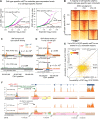Impact of regulatory variation across human iPSCs and differentiated cells
- PMID: 29208628
- PMCID: PMC5749177
- DOI: 10.1101/gr.224436.117
Impact of regulatory variation across human iPSCs and differentiated cells
Abstract
Induced pluripotent stem cells (iPSCs) are an essential tool for studying cellular differentiation and cell types that are otherwise difficult to access. We investigated the use of iPSCs and iPSC-derived cells to study the impact of genetic variation on gene regulation across different cell types and as models for studies of complex disease. To do so, we established a panel of iPSCs from 58 well-studied Yoruba lymphoblastoid cell lines (LCLs); 14 of these lines were further differentiated into cardiomyocytes. We characterized regulatory variation across individuals and cell types by measuring gene expression levels, chromatin accessibility, and DNA methylation. Our analysis focused on a comparison of inter-individual regulatory variation across cell types. While most cell-type-specific regulatory quantitative trait loci (QTLs) lie in chromatin that is open only in the affected cell types, we found that 20% of cell-type-specific regulatory QTLs are in shared open chromatin. This observation motivated us to develop a deep neural network to predict open chromatin regions from DNA sequence alone. Using this approach, we were able to use the sequences of segregating haplotypes to predict the effects of common SNPs on cell-type-specific chromatin accessibility.
© 2018 Banovich et al.; Published by Cold Spring Harbor Laboratory Press.
Figures




References
-
- Alasoo K, Rodrigues J, Mukhopadhyay S, Knights AJ, Mann AL, Kundu K, Consortium H, Hale C, Dougan G, Gaffney DJ, et al. 2017. Genetic effects on chromatin accessibility foreshadow gene expression changes in macrophage immune response. bioRxiv 10.1101/102392. - DOI
Publication types
MeSH terms
Substances
Grants and funding
- P30 DK042086/DK/NIDDK NIH HHS/United States
- R01 HL092206/HL/NHLBI NIH HHS/United States
- T32 HL007381/HL/NHLBI NIH HHS/United States
- R01 MH084703/MH/NIMH NIH HHS/United States
- T15 LM007033/LM/NLM NIH HHS/United States
- F31 AG044948/AG/NIA NIH HHS/United States
- T32 GM007281/GM/NIGMS NIH HHS/United States
- T32 MH020065/MH/NIMH NIH HHS/United States
- U01 HG007036/HG/NHGRI NIH HHS/United States
- T32 GM007197/GM/NIGMS NIH HHS/United States
- R01 MH101825/MH/NIMH NIH HHS/United States
- U54 CA149145/CA/NCI NIH HHS/United States
LinkOut - more resources
Full Text Sources
Other Literature Sources
Molecular Biology Databases
